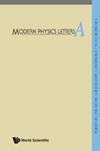被完美流体暗物质包围的巴丁黑洞的准正态模式、霍金辐射和无质量标量场的吸收
IF 1.6
4区 物理与天体物理
Q3 ASTRONOMY & ASTROPHYSICS
引用次数: 14
摘要
研究了被完美流体暗物质包围的巴丁黑洞在无质量标量场中的准正态模态、霍金辐射和吸收截面。我们的结果表明,准正态模式的振荡频率随着磁荷[公式:见文]或暗物质参数[公式:见文]的增加而增强。对于准正态模态的阻尼率,它们的影响是不同的。具体来说,暗物质参数的增大[公式:见文]使阻尼率先增大后减小。而阻尼率则随着磁荷的增加而不断减小[公式:见文]。此外,我们发现暗物质参数[公式:见文]的增加增强了功率发射光谱,而磁荷[公式:见文]抑制了功率发射光谱。这意味着当其他参数固定时,[公式:见文]的值越小,[公式:见文]的值越大,黑洞的寿命越长。最后,利用部分波方法计算了所考虑黑洞的吸收截面。我们的结果表明,吸收截面随着暗物质参数[公式:见文]或磁荷[公式:见文]的增加而减小。本文章由计算机程序翻译,如有差异,请以英文原文为准。
Quasinormal modes, Hawking radiation and absorption of the massless scalar field for Bardeen black hole surrounded by perfect fluid dark matter
We study the quasinormal modes, Hawking radiation and absorption cross-section of the Bardeen black hole surrounded by perfect fluid dark matter for a massless scalar field. Our results show that the oscillation frequency of quasinormal modes is enhanced as magnetic charge [Formula: see text] or the dark matter parameter [Formula: see text] increases. For damping rate of quasinormal modes, the influence of them is different. Specifically, the increase of dark matter parameter [Formula: see text] makes the damping rate increasing at first and then decreasing. While the damping rate is continuously decreasing with the increase of the magnetic charge [Formula: see text]. Moreover, we find that the increase of the dark matter parameter [Formula: see text] enhances the power emission spectrum whereas magnetic charge [Formula: see text] suppresses it. This means that the lifespan of black holes increases for smaller value of [Formula: see text] and larger value of [Formula: see text] when other parameters are fixed. Finally, the absorption cross-section of the considered black hole is calculated with the help of the partial wave approach. Our results suggest that the absorption cross-section decreases with the dark matter parameter [Formula: see text] or the magnetic charge [Formula: see text] increasing.
求助全文
通过发布文献求助,成功后即可免费获取论文全文。
去求助
来源期刊

Modern Physics Letters A
物理-物理:核物理
CiteScore
3.10
自引率
7.10%
发文量
186
审稿时长
3 months
期刊介绍:
This letters journal, launched in 1986, consists of research papers covering current research developments in Gravitation, Cosmology, Astrophysics, Nuclear Physics, Particles and Fields, Accelerator physics, and Quantum Information. A Brief Review section has also been initiated with the purpose of publishing short reports on the latest experimental findings and urgent new theoretical developments.
 求助内容:
求助内容: 应助结果提醒方式:
应助结果提醒方式:


